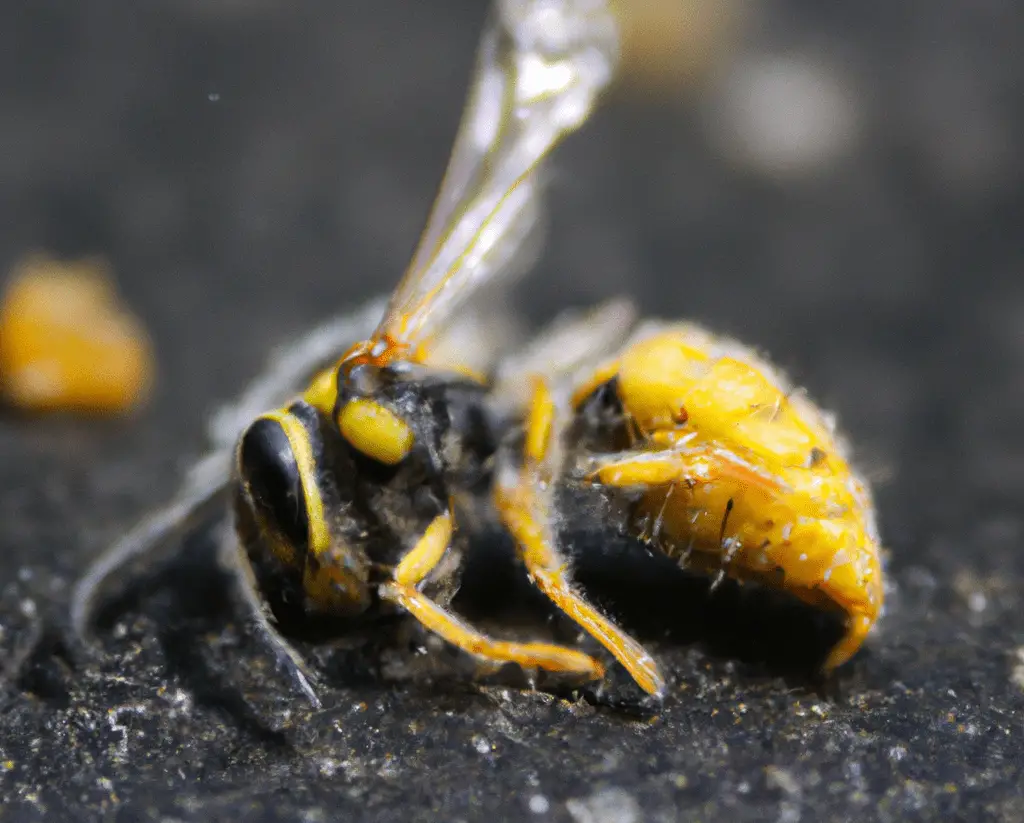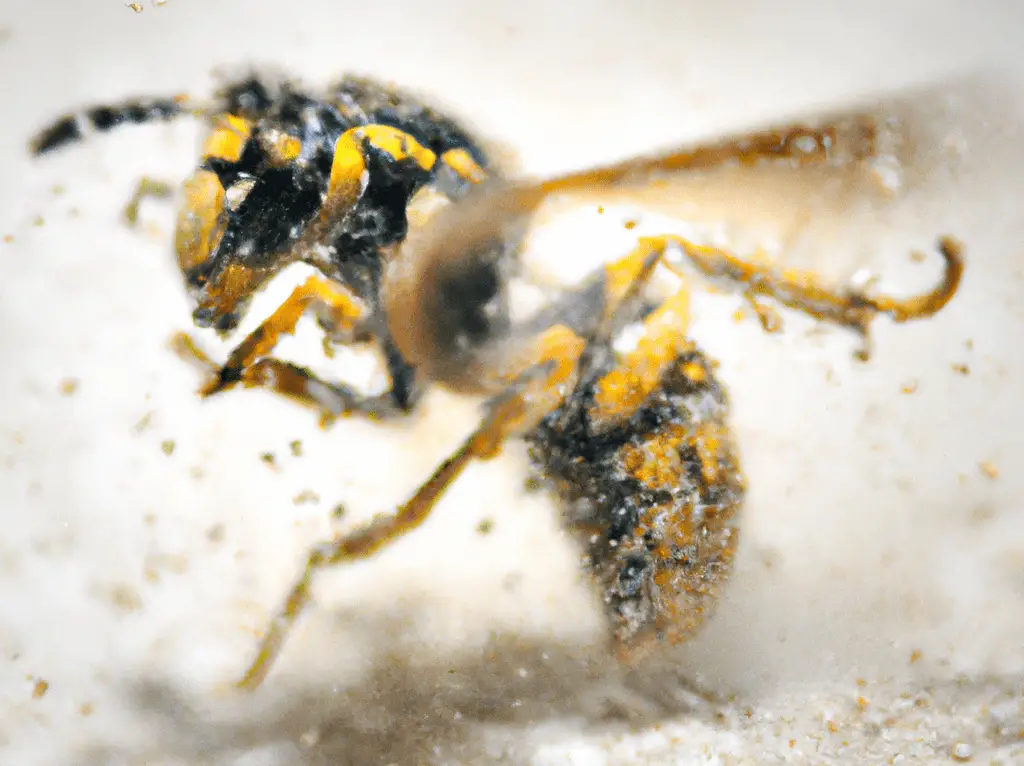Pyrethroid insecticide comes in many forms and knocks down and kills countless types of insect pests. The active ingredient cyfluthrin is found in chrysanthemums and effectively kills insects on contact but sometimes lacks any residual control. Commercial wasp spray is common to kill insects that have entered our homes or are in visible locations around our yards, but some have toxic chemicals that are easily inhaled and lack penetration into wall voids.
Sometimes a stinging insect or other pest nests in wall voids needs to be handled, and sprays can not offer the excellent penetration that insecticide dust can. There are many popular dust insecticides for wasps and bee nests, like Bayer Delta Dust Insecticide Powder but the most effective dust for yellow jackets is Tempo Dust.
Read on to learn how to use the active ingredient Bayer Tempo Dust to destroy wasp nests in indoor and outdoor applications.
What is Tempo Dust?
This is a popular dust for bees that is specially formulated to take down yellow jackets, wasp nests, and other angry wasps. Bayer Tempo Insecticide concentrate has a long shelf life and needs no mixing or additional chemicals to be effective. Dust for bees and other pests should only be used in non-food areas and never directly on utensils or food storage shelves.
Tempo dust is the ideal product for hard-to-reach areas where yellow jacket nests usually are. Bayer Tempo Dust Insecticide Powder offers long-term residual control of up to a year if left undisturbed. It is an affordable product and an excellent method of pest control against yellow jackets, hornets, bedbugs, fire ants, and all other painful pests.
What Types of Pests Can Tempo Dust Kill?
While being marketed as the most effective wasp dust, it is also a control of pests that crawl and borrow too. Ants, termites, cockroaches, moths, beetles, and silverfish are all insects that Tempo dust kills. The main benefit is the dust nest effect that kills entire colonies of crawling and flying pests and is one of the fastest and safest methods of pest control available.
| Pest | Area Found | How To Kill |
| Ants | Around doors and windows, any cracks or crevices where ants have been seen | Sprinkle the powder around perimeters and dust entrance to the ant colony |
| BedBugs | Mattress folds, bedding, around closets, and clothes dressers | Check the product label for the dosing amount, then dust all areas suspected of bedbugs with liberal amounts of Tempo |
| Carpet Beetles | Floor coverings, hardwood cracks, and under furniture | Spread dust all around baseboards, and any wall cavity beetles may retreat to use a power duster for maximum penetration |
| Moths and Silverfish | Closets, drawers, cabinets, and cupboards | Dust in the corners of all non-food/feed areas and leave for long-term residual control |
| Fire Ants | Yards and Lawns | Place dust in and around mounds and add water gently to force chemicals deeper inside the colonies for total control of ants |
| Termites and Wood Borers | Dead yard materials, crawl spaces, and wooden materials | Cover wooded surfaces with dust and blow powdered into subterranean colonies and current termite nests |
| Bees, Wasps, Hornets, and Yellow Jackets | Behind sheds, in attics, garages, and under decks and porches | Wait until the evening when activity by worker wasps has decreased and all the bees are in the nest, then cover the area with powder and check the following day for results |
How To Use Tempo Dust?
The way to use Tempo dust depends on which type of pest you are trying to eradicate. Flying insects, crawling insects, and entire nests all need to be treated differently. Tempo dust can also be applied as a residual preventive pest control measure that keeps ants and termites from entering wall sockets and cavities and building nests.
Flying Insects

It is hard to use dust on insects that spend very little time on the ground, such as flies and mosquitos. It is unlikely that the insects will land on the powder, and if they do, the contact may not be sufficient to kill the insects. More stationary pests like wasps and bees that can be caught while they are feeding or nesting can be wiped out by Tempo dust.
Using a hand duster or power duster to blast Tempo all over the areas where wasps and bees are likely to feed, and land is the best way to ensure complete coverage. Try to coat the colony entrance so that any bees crawling in and out will get covered in the chemicals and perish. It is difficult to use Tempo to prevent wasps nests from being built but is effective at treating workers that leave the nests and enter your home.
Crawling Insects
Ants, cockroaches, bedbugs, and other things that crawl can quickly invade homes and build big populations. It can be very difficult to see the nocturnal pests that move when we are sleeping or not at home. Using a dust like Tempo can catch the pests while you are away with long-term residual effects.
Closets and baseboards are common places where crawling insects can be found and should be dusted with insecticide. Make sure to blow the dest deep into wall cavities where it will remain undisturbed and can act as a barrier against future bugs like termites and beetles.
Nests and Colonies
The best feature of Tempo dust is that it can quickly and safely bring down an entire nest of yellow jackets and hornets without having to contact them directly at the time of application. You will not need to dust bees that are actively trying to sting you if you blow the powder into the nest or area where the colony is first.
If you cannot access the nest directly, you can drill a hole near where the wasp activity is. Once evening comes and the wasps have settled down, using a power duster to throw Tempo inside the walls and get as much on the nest as possible. Monitor the entrance hole for a few days and try to remove the nest as soon as possible to avoid other pest problems.
Tempo Dust Application Techniques and Safety Tips
While Tempo Dust is effective at killing yellow jackets and wasps to keep you and your family bee sting free it does come with some risks. As with any other insecticide, care should be taken when applying and storing it to avoid accidental ingestion and any other toxic side effect. These safety tips will help you use the product correctly and avoid any mishaps.
Use Dry
Tempo is a no-mix needed ready-to-use product that should be applied with a duster dry. Adding water or any other solution will negatively impact the effectiveness of the insecticide and may lead to more toxic and dangerous compounds. Make sure to use the proper dust blowers to get the product inside of walls and cracks and not just on the surface or entrance of the holes.
Apply in places Inaccessible to Pets and Children
It is toxic if ingested and should be kept away from pets and children while it is stored. Additionally, anywhere the powder will be applied must be out of reach of non-targeted pests, or inadvertent poisoning could ensue. Try to use the product when no wind or strong breeze is present to avoid spreading it to unintended areas.
Do Not apply Near Food or Dining Surfaces
Tempo insecticide dust should never be used on food prep surfaces or on utensils or dishes that will come into contact with food. If the dust is accidentally used in food areas, clean all surfaces thoroughly with hot water and cleaner before using it for food again. Vacuum up all dust when you want to remove the residual powder from areas that were previously treated for pests.
Safety Gear
Applying the dust can be dangerous as the slightest breeze can send it back into your face. It is not advisable to touch Tempo with your skin, and inhaling and ingesting it can cause issues. Wear gloves and a respirator mask to prevent accidental ingestion and to keep you safe as you apply it. Extra protection may be needed to protect against yellow jacket stings if that is the pest you are treating.




